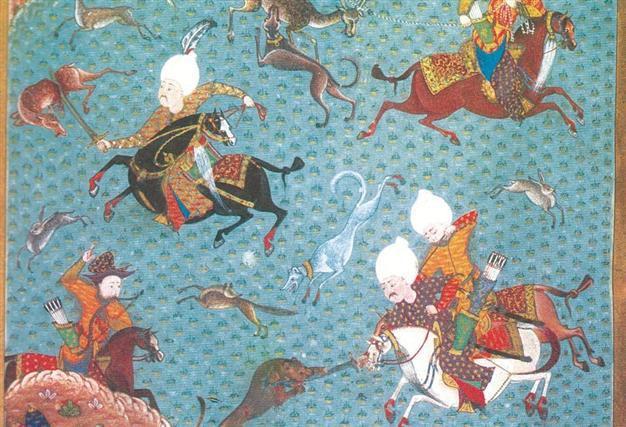‘The superiority of dogs…’
NIKI GAMM

Sultan Suleyman looks on as Prince Selim hunts with dogs.
Thirty-three thousand years ago and counting is the most recent, provable estimate as to how long dogs have been companions of mankind. Their origins are also debatable – Far East? Middle East? Does it really matter?The peoples of the Middle East have had somewhat ambivalent attitudes towards dogs, ranging from total fear to greater love than that felt for family and friends. The fear is understandable. A dog’s teeth are a vicious weapon and there was no cure for rabies until the late 19th century.
One of the oldest breeds in the Middle East is that of the saluki, a type of hound that hunts by sighting its prey and then chasing it down. Bedouins for centuries have treasured the saluki, regarding it as clean and even allowing it to stay in their tents while other dogs were excluded. The Iranians considered it to be a royal dog. Pictures of salukis can be found in Egyptian tombs and much later in Persian and Ottoman manuscripts. A second breed is the basenji which descended from Central African dogs. They’ve also been portrayed in the tombs of the pharaohs.
The ancient Persians seem to have adopted the Saluki but they additionally bred a large, mastiff dog which was used on farms and in sheep herding.
Anatolia also was and is home to the famous Kangal dog, also a mastiff though somewhat smaller and lighter than other mastiffs. It was and is kept as a watch dog which would guard flocks and also people’s homes. The Kangal is mentioned in 17th century travel writer Evliya Çelebi’s work.
The ancient Greeks had several types of dogs – one was the Meliteo Kinido, a small, long-haired type which is good for herding, defense of home and killing vermin. The others were the Spartan and the Molossian. The Spartan which was swift was used for hunting while the Molossian was seen as suitable for guarding flocks and homes. Several Roman authors such as Virgil and Varro mention these two latter breeds in discussions of what kind of dog was most useful for farms.
Several other breeds are mentioned by various writers and their point of origin well-known. However, a particular one called the Vertragus was extremely valuable, is described as being a sight hound and possibly today it may be known as the Italian gray hound. Arrian, a second century Roman historian who spent most of his life in Anatolia, had a grey-eyed Vertragus of which he wrote, “… so for all who have had such a companion: she was ‘most swift and wise and divine.’” Although Arrian doesn’t go into details, the fact that the bitch had grey eyes suggests it was not a Saluki because they have dark to hazel-colored eyes.
Dogs and Islam
Dogs played an important role in pre-Islamic poetry and especially in works that describe the hunts for the oryx, a large antelope with straight but extremely dangerous horns. The Bedouins of the Arabian Peninsula hunted the oryx as much for food as for the excitement of the chase. When the Qur’an was revealed, it included a passage extolling the hunt, thus ensuring that dogs such as the saluki maintained its important position and even be considered a part of the family. The Qur’anic verse (5:4) is part of a discussion on what foods are permitted to the Muslim. “The good things are allowed to you, and what you have taught the beasts and birds of prey, training them to hunt – you teach them of what Allah has taught you; so eat of that which they catch for you and mention the name of Allah over it; and keep your duty to Allah.”
The problem lies in the fact that Muslims have to be ritually pure when they pray, dogs are considered unclean. It doesn’t matter that they’re useful for hunting guarding herds and homes. Keeping the dog in the confined space of a house would contaminate the cleanliness of the place and smell up the house, not to mention the fact that dogs eat unclean things. In the introduction to a tenth century work by Ibn al-Marzuban, The Book of The Superiority of Dogs over many of Those who wear Clothes [translated and edited by G.R. Smith and M.A.S. Abdel Haleem], some of the critical remarks found in the “Hadith” (“Traditions”) include a quotation that “no angel will visit a house in which a dog is kept.” This apparently was derived from the story of the Angel Gabriel visiting the Prophet to deliver a revelation. When he discovered a puppy in the room, he went away.
Such statements as the one above led to differences in opinion among the various schools of religious law that had developed in Muslim lands. Where the Maliki school accepted the ritual cleanliness of the dog, the Shafi school did not. The Hanifi school which is by far the largest branch of Muslim law and was adopted by the Ottomans went so far as to declare the dog’s saliva even was unclean.
The book on the superiority of dogs consists of poems and short stories relating to the untrustworthiness of man and the friendship of dogs even if their masters discipline them. The poet Abu Haffan for instance is quoted:
“Don’t be surprised when you see me on foot in your midst,
when the riff-raff are mounted.
If the riff-raff are above the noble, it is not surprising:
scum floats above water and froth!”
Among the stories is one in which a man relates how he was returning from a war with a friend. They stopped for a while and after he had gotten tipsy, his friend tied him up and threw him into a stream bed. He took all his booty and fleeing, left him to die. A dog came and sat down next to him and then went away. It returned with a loaf of bread and gave it to the man to eat. This happened three days in a row but on the third day, the man’s son who had become curious about the dog’s behavior arrived and rescued his father. They took the dog home with them and the rescued man kept it close, covering it with his own cloak even though it wasn’t a hound.
And so the dog is accepted among the Arabs and elsewhere for its hunting and guarding abilities and its loyalty to man.
















